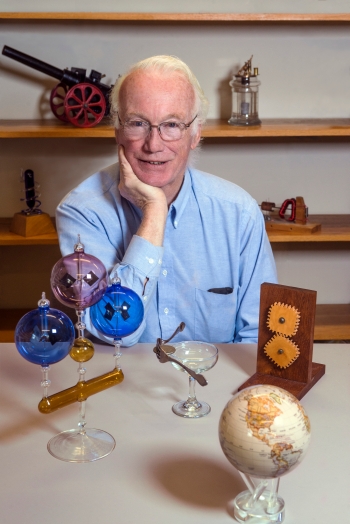
By
Growing up in the small farming town of Davis, Calif., in the shadows of World War II, T. Ross Kelly learned early on that fun to be had was fun that had to be made.
As a boy, Kelly’s preferred toys tended toward rocket kits and go-carts — devices that were as fun to assemble, as they were to use. If they produced flames and smoke, all the better.
“When I was a kid, we used to blow things up,” said Kelly, the Thomas A. and Margaret A. Vanderslice Professor of Chemistry.
That love of toys — for lack of a better word — is still evident in Kelly’s Merkert Chemistry Center office. His bookshelves contain almost as many shiny, glittering, spinning and whirling gadgets as they do chemistry texts collected during his 45-year career.
Each gizmo either poses puzzling scientific questions, or teaches a lesson about a law of science or nature. It’s a collection that started out rather innocently 25 years ago when Kelly spotted a toy in a stall in a street market in Italy.
The figurine of a soccer player stands with a soccer ball floating above his head thanks to a flow of air supplied by a whirling fan. It highlights Bernoulli’s principle, which explains how birds and planes fly.
“At the time, in our lab we were trying to figure out how to make a molecule function like a motor, but initially we couldn’t figure it out,” said Kelly. “Searching for ideas, anytime I saw something operated by a motor, I would buy it.”
Kelly and his team eventually achieved the ambitious end point of their work, and the innovative project results were published in the journal Nature.
Over the years, Kelly’s collection has grown. Some, like his chemically charged miniature cannons, find their ways into his legendary Organic Chemistry lectures.
Now a few new gadgets from the digital age — the Internet, Google and Facebook — have given Kelly the opportunity to share his collection with a broader audience. With the help of pre-med undergraduates Jacy Lundberg ’15 and Omar Khan ’15, Kelly has developed a video blog he calls “A Scientist’s Curiosity Cabinet” [see http://bit.ly/15SZk6S] – a play on the science-themed showcases that date back to the Renaissance – where short videos highlight certain toys and the lessons they can teach.
There are wooden “walking toys” driven by constantly shifting centers of mass. Inside a glass bottle, centripetal acceleration solves the riddle of how to move a wooden ball past a wooden stick. Egg-shaped gears turn harmoniously despite their toothy imbalance. There are puzzlers where metal spheres and galvanized spikes fit into spaces they seemingly should not.
“With many of these, the answer is staring you right in the face,” said Kelly. “Sometimes it just takes time to stop and think and consider what you’re looking at or holding in your hand. Sometimes even that doesn’t work. But it’s fun trying.”
His favorite is the Dobereiner Lighter, a two-chambered curio where sulfuric acid and zinc react, producing hydrogen gas which then reacts with platinum gauze and sparks a flame.
“I especially like it because it’s really ingenious and it’s all chemistry,” said Kelly, who, among other honors, is a fellow of the American Association for the Advancement of Science.
Kelly hopes the video blog and its accompanying Facebook page can help science teachers and students at any level and he’s letting 18,000 science teachers know about the site. Science, he notes, is often unfairly viewed as a grind. It does require hard work, but it can and should be fun, he said.
“I would really like to use it to turn kids on to science,” said Kelly. “Science doesn’t have enough fans among young people – at least in the United States. I’d like to help change that.”



